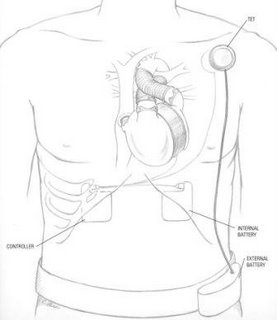 I would like to comment on the letter written by the UVA biology faculty when they responded to the article “Ultimate Questions”. My comments are in blue and indented. I feel the faculty letter has misrepresented the theory of intelligent design and employed several popular, but less then proper, debating tactics to try and win the favor of the reading audience. Several pieces of false information were also provided regarding the lack of evidence for ID, and the supposed lack of journal publications for ID.
I would like to comment on the letter written by the UVA biology faculty when they responded to the article “Ultimate Questions”. My comments are in blue and indented. I feel the faculty letter has misrepresented the theory of intelligent design and employed several popular, but less then proper, debating tactics to try and win the favor of the reading audience. Several pieces of false information were also provided regarding the lack of evidence for ID, and the supposed lack of journal publications for ID.
Given that ID is based on the empirical observable evidence, and not derived from any religious text, it was surprising that the faculty brought up religion several times. What is their agenda or motive for bringing religion into a science debate over origins and biological complexity and design? Why do they not debate the facts and leave the straw man and ad hominem arguments to lesser minds?
Sincerely
Lee Penick
82’ USAFA, Colorado
86’ Wright State University, Ohio
We were distressed by the article "Ultimate Questions," not because it raised questions about scientific theory and observations, but rather because it failed to properly characterize the religious basis for an increasingly vocal attack on science.
Straw man attack – ID makes an inference from the biological evidence and does not represent an attack on science. No evidence is presented here to support that misleading claim.
The article failed to state that the purpose of the IDEA Club is not merely to debate evolution and religion, but (as stated in their charter) to "promote, as a scientific theory, the idea that life was designed by an intelligent designer." The argument that has been made is that gaps in scientific knowledge can be used to prove a supernatural and theological explanation for natural phenomenon.
Straw man. ID does not argue for the supernatural, it supports the ability to distinguish between an intelligent cause vs. a natural or non-intelligent cause. This is well documented in PhD Dembski’s writings. This represents a fundamental misunderstanding about the theory of intelligent design or a purposeful attempt to misrepresent it.
This is an attempt to disguise theology as science, and the simple conclusion would be that the less we know, the greater is the support for supernatural explanations.
This attempts to misleadingly frame the ID theory without understanding it. We actually know a lot about intelligent causes and use this methodology for archeology, SETI, forensic science, encryption, and detection of ID in biological systems. This is also well documented in the literature and is surprising that a science dept would not know this or portray it correctly.
The great advance of the Enlightenment has been the search for natural explanations for natural phenomena. While the article appears to represent a balanced view of the controversy, arguments from the proponents of intelligent design are presented without rebuttal. It might be assumed by a reader who is not an expert that valid flaws in evolutionary theory have been exposed. For example, a sidebar in the article presents the example of the bacterial flagellum, a seemingly complicated apparatus used for swimming that contains approximately 40 different proteins. According to the proponents of intelligent design, it "could not have started unless an intelligent agent put the right pieces in place, together at the same time. Proponents of intelligent design argue that the likelihood that such complexity, with so many dependent parts, arose randomly is virtually nil." What the article fails to discuss is that the flagellar assembly is known to be homologous, that is to share common origins, with the bacterial Type Three Secretion System, and thus evolution can explain how a secretory system evolved into one capable of both secretion and motility.
This plays loose and free with the facts. This is an assumption based on similarity, and not experimental evidence. Correlation in looks or biological parts does not demonstrate much less prove the causal method of origin. Dembski said it well when answering a critic who brought up a similar charge:
“Miller is presupposing precisely the point in question, namely, whether evolution, a materialistic form of it, can bring about biological complexity. Sample enough organisms, and you’ll find structures in different states of complexity that perform the same basic function. But arranging such structures according to some similarity metric and then drawing arrows marking supposed evolutionary relationships does nothing to show whether these systems in fact evolved by material mechanisms. Similarity may suggest evolutionary relationships, but evolution is a process, and the evolutionary process connecting similar structures needs to be made explicit before the similarity can legitimately be ascribed to evolution. Miller’s analysis never gets that far. He gestures at similarities but never demonstrates how evolution accounts for them.”
William Dembski
We think that the attention given to ID is due to the lack of understanding about evolution.
There is truly a controversy that should be taught. There are large disagreements over what mutations and natural selection can account for in biology. ID supports teaching this controversy so that students are educated and not indoctrinated.
It is safe to assume that if the IDEA Club was constituted to promote as a scientific theory the notion that earthquakes are caused by God, and not by plate tectonics, it would receive less favorable coverage. Unfortunately, earthquakes are accepted by more people as a natural phenomenon than is biological evolution. According to the Pew Survey, approximately 50 percent of adults in the United States believe that humans first appeared on the earth in their present form within the past 5,000 to 10,000 years. The notion that humans actually evolved from more primitive life forms, supported by vast amounts of data from fields as diverse as paleontology and molecular genetics, is antithetical to those who do not accept evolution. If humans are the product of an intelligent design, should we also conclude that pathogens, such as Salmonella and HIV, responsible for killing millions of children every year, are also intelligently designed?
Straw man. Does not deal with the markers of Irreducible complexity and Complex Specified Information as empirical markers of ID. Is this truly the extent of the faculties understanding of the theory of intelligent design. This is embarrassing. Why not use science and utilize the techniques of ID to determine if there are portions of “Salmonella and HIV” that qualify as IC or CSI?? The number of people killed does not influence the outcome of this study.
Why is the concept of evolution so troubling to proponents of ID? Not only does evolution clash with religious dogma, but it undermines the significance that some would like to give to the place of humans in the universe. Most people are unaware of the resistance 400 years ago to the notion that the earth revolves around the sun, a climate that led to Galileo’s public recantation of this notion under the threat of torture. The opposition to a heliocentric theory of the solar system was due to the conflict with religion, and was sustained by the desire to imagine that we occupy a special place in existence. It appeared more comforting to those who opposed Galileo to believe that we were the center of the universe, rather than that the earth is one of many planets that revolves around the sun, which is but one of many stars. It is quite disappointing that 22 percent of U.S. adults recently surveyed by the Washington Post (reported in the March 30 issue) thought that the sun revolves around the earth, rather than vice versa, so while progress has been made since the time of Galileo, it is not as rapid as one might have hoped.
How does this relate to ID and its ability to detect design vs. natural cause or chance occurrence?
The current conflict between the science of evolution and attempts to teach creationism or ID disguised as science can be seen in the same light as the resistance to a heliocentric theory of the solar system. It may be more comforting to some to imagine that we were created in our present form than that we share common origins with chimpanzees, mice and even bacteria. The article did a disservice to the extensive body of data in support of evolution by placing the religiously motivated remarks of a few on a seemingly equal footing with real observations and experiments.
What religious motive…ID is supported by Jews, Muslims, Christians, agnostics, and A. Flew who was a prominent atheist. Whose religion or lack of religion is being supported here?
Where have you observed macro evolution (not micro) or have experiments to show it? When we look at the causal history of any irreducible complex item where we actually know the cause for sure, when has it NOT been the product of intelligent design?
It was stated that "Few peer-reviewed scientific studies [in support of ID] have been published in the major scientific journals," but a more accurate statement would be that no peer-reviewed scientific studies in support of ID have ever been published in any major scientific journal.
False statement.
1) Discovery Institute Bibliography w/ peer reviewed articles which challenge evolution http://www.discovery.org/scripts/viewDB/index.php?command=view&id=1127
2) Discovery Institute list of peer reviewed articles which support ID http://www.discovery.org/scripts/viewDB/index.php?command=view&program=CSC%20-%20Scientific%20Research%20and%20Scholarship%20-%20Science%20-%20MainPage&id=2640
Jefferson recognized that reasoned debate and the free exchange of ideas constituted the very core of democracy in America. However, theories such as ID, that invoke religious themes due to a purported lack of scientific facts, have no credibility or standing in the teaching of science in the United States.
ID is based on the empirical observable evidence. It does not derive from any religious text. ID does not bring up religion, why do these biologist? What is their agenda or motive for bring religion into a science debate over origins and biological complexity and design?
The term “purported lack of scientific facts” is used above, but the unawareness of scientific facts is not the same as the facts not existing. In this case, it may simply be that the faculty who signed this letter did not agree with or were possibly not aware of the facts. Here is a very short summary:
Over the last 4-5 decades, biochemists have made progress toward understanding life's chemistry. The cell's major biochemical systems have been identified and characterized. These advances have exposed numerous features that provide strong evidence in favor of the intelligent design argument.
Chicken-and-egg systems: Many biochemical systems are called chicken-and-egg systems (after the old conundrum, "Which came first: the chicken or the egg?") because they consist of components that require each other for the components to be produced. For example, ribosomes make proteins, yet they in turn consist of proteins. Proteins can't be formed without ribosomes (proteins), and ribosomes (proteins) can't be made without proteins!
Fine-tuning and high precision: Long recognized as design features, fine-tuning and high precision traditionally signify a device's superior engineering and craftsmanship. Many biochemical structures and activities depend on precise location and orientation of chemical groups in three-dimensional space, just-right chemical composition, and exacting chemical rates. Molecular fine-tuning is a defining property of life's chemical systems.
Compositional fine-tuning and complexity of cell membranes: These structures form the cell's external and internal boundaries and require precise chemical compositions to assemble. Cell membranes possess vast complexity: Both reflect design.
Molecular motors: These protein complexes are found inside the cell and are literal machines. Many possess an eerie resemblance to man-made machines. A new special issue of Journal of Physics: Condensed Matter edited by Joseph Klafter and Michael Urbakh contains invited papers from some of the world's greatest experts on molecular motors. Macro-scale thermodynamic engines convert the random motion of fuel-produced heat into directed motion. Such engines cannot be downsized to the nanometer scale, because thermodynamics does not apply to single atoms or molecules, only large assemblies of them. A great challenge for the field of nanotechnology is the design and construction of microscopic motors that can transform input energy into directed motion and perform useful functions such as transporting of cargo. Today's nanotechnologists can only look in envy at the biological world, where molecular motors of various kinds (linear, rotary) are very common and fulfill essential roles.
Biochemical information systems: Experience teaches that intelligible messages come from intelligent sources. The cell's biochemical machinery (proteins, DNA, RNA, and oligosaccharides) is information-based and therefore its logical to infer that it comes from an intelligent source.
Genetic code: Encoded information indicates intelligence beyond the mere presence of information. An intelligent being must develop and employ the code. The cell's information exists in a coded format that defines the cell's information systems.
Genetic code fine-tuning: The rules that comprise the genetic code are better designed than any conceivable alternative code to resist error caused by mutations. This fine-tuning powerfully indicates that a superior intelligence developed the cell's information systems.
Preplanning: Planning ahead indicates purpose and reflects design. Many biochemical processes consist of a sequence of molecular events and chemical reactions. Often the initial steps of these pathways elegantly anticipate the final steps.
Quality control: Designed processes incorporate quality-control procedures to ensure efficient and reproducible manufacture of quality product. Many biochemical operations employ sophisticated quality control processes.
Molecular convergence: Several biochemical systems and/or biomolecules found in different organisms are structurally, functionally, and mechanistically identical. Yet they appear to have independent origins. Given the complexity of these systems, it is not rational to conclude that blind, random, natural processes independently produced them.
Man can't do it better: Humans' attempts to duplicate the cell's complex and elegant chemical processes in the laboratory frequently fail. When scientists can mimic these systems, their best efforts are crude cumbersome, and inefficient. How can blind, random events account for the elegance of life's chemistry when the world's best researchers fail?
The collective weight of evidence argues design and this was a short summary without great detail. When complex specified information (CSI) is used as an empirical marker for design, it is used such that the probability is equal to or less than one chance in 10^150. This is explained in detail in Dembski’s writings. So an item that fits this criteria isn’t just complicated or complex, it exceeds the probabilistic resources of a 15 billion year old universe to produce by chance.
This is hardly a “God in the Gaps” approach, and while there is strong resistance to ID in academia, there are also interested academics who are turning to ID as a method to truly research origins and follow the evidence they are discovering in microbiology. Why should we fear the evidence, unless we are protecting an ideology?
Lee Penick
Adler, Paul N. – Department of Biology
Auble, David T. – Department of Biochemistry and Molecular Genetics
Bauerle, Ronald H. – Department of Biology
Beyer, Ann L. – Department of Microbiology
Bradbeer, Clive – Department of Biochemistry and Molecular Genetics
Brautigan, David L. – Department of Microbiology
Brown, Jay C. – Department of Microbiology
Bullock, Timothy N. – Department of Microbiology
Burke, Daniel J. – Department of Biochemistry and Molecular Genetics
DeSimone, Douglas W. – Department of Cell Biology
Dutta, Anindya – Department of Biochemistry and Molecular Genetics
Egelman, Edward H. – Department of Biochemistry and Molecular Genetics
Fox, Jay W. – Department of Microbiology
Grigera, Pablo R. – Department of Microbiology
Hamlin, Joyce L. – Department of Biochemistry and Molecular Genetics
Hammarskjold, Marie-Louise. – Department of Microbiology
Horwitz, A. Rick – Department of Cell Biology
Kedes, Dean H. – Department of Microbiology
Khorasanizadeh, Sepideh – Department of Biochemistry and Molecular Genetics
Kupfer, Gary M. – Department of Microbiology
Lannigan, Joanne A. – Department of Microbiology
Ley, Klaus – Department of Biomedical Engineering
Li, Chien – Department of Pharmacology
Li, Rong – Department of Biochemistry and Molecular Genetics
Lindorfer, Margaret – Department of Biochemistry and Molecular Genetics
Lynch, Kevin – Department of Pharmacology
Macara, Ian G. – Department of Microbiology
Macdonald, Timothy L. – Department of Chemistry
McDuffie, Marcia J. – Department of Microbiology
Menaker, Michael – Department of Biology
Minor, Wladek – Department of Molecular Physiology and Biophysics
Moskaluk, Christopher A. – Department of Molecular Physiology and Biophysics
Nakamoto, Robert – Department of Molecular Physiology and Biophysics
Noramly, Selina – Department of Biochemistry and Molecular Genetics
Osheim, Yvonne – Department of Microbiology
Rissman, Emilie – Department of Biochemistry and Molecular Genetics
Rivera-Nieves, Jesus – Department of Internal Medicine
Roberts, Margo R. – Department of Microbiology
Ross, William G. – Department of Internal Medicine
Schwartz, Martin A. – Department of Microbiology
Smith, Michael F. – Department of Microbiology
Stukenberg, P. Todd – Department of Biochemistry and Molecular Genetics
Tamm, Lukas K. – Department of Molecular Physiology and Biophysics
Taylor, Ronald P. – Department of Biochemistry and Molecular Genetics
Thompson, Thomas E. – Department of Biochemistry and Molecular Genetics
Wertz, Gail W. – Department of Pathology
White, Judith M. – Department of Cell Biology
Wiener, Michael C. – Department of Molecular Physiology and Biophysics
Wotton, David – Department of Biochemistry and Molecular Genetics
 Much to his chagrin, it’s time for a battery replacement and no one in the medical community believes Dawkins when he claims he has an artificial heart. He knows, however, if he doesn’t get the new battery, he dies.
Much to his chagrin, it’s time for a battery replacement and no one in the medical community believes Dawkins when he claims he has an artificial heart. He knows, however, if he doesn’t get the new battery, he dies.



